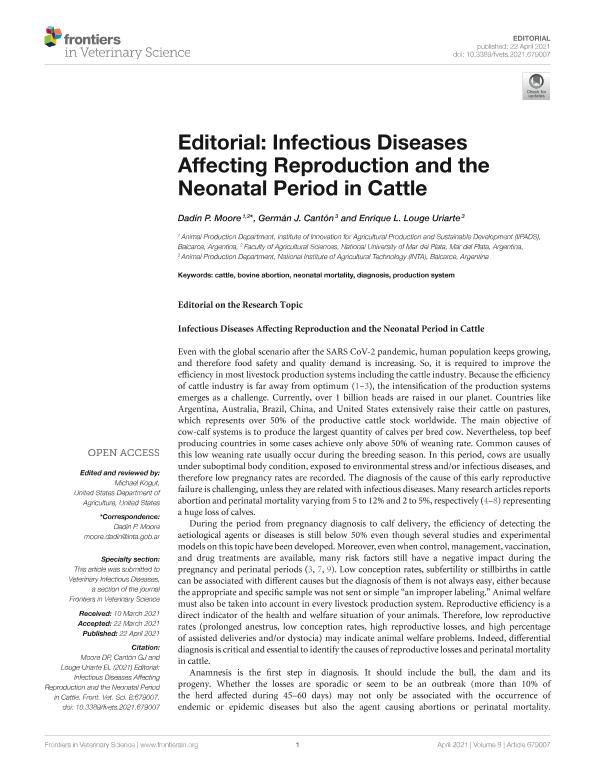Mostrar el registro sencillo del ítem
dc.contributor.author
Moore, Dadin Prando

dc.contributor.author
Cantón, Germán J.
dc.contributor.author
Louge Uriarte, Enrique Leopoldo

dc.date.available
2022-11-09T18:45:28Z
dc.date.issued
2021-04
dc.identifier.citation
Moore, Dadin Prando; Cantón, Germán J.; Louge Uriarte, Enrique Leopoldo; Editorial: Infectious Diseases Affecting Reproduction and the Neonatal Period in Cattle; Frontiers Media; Frontiers in Veterinary Science; 8; 679007; 4-2021; 1-3
dc.identifier.uri
http://hdl.handle.net/11336/177120
dc.description.abstract
Editorial on the Research TopicEven with the global scenario after the SARS CoV-2 pandemic, human population keeps growing, and therefore food safety and quality demand is increasing. So, it is required to improve the efficiency in most livestock production systems including the cattle industry. Because the efficiency of cattle industry is far away from optimum (1?3), the intensification of the production systems emerges as a challenge. Currently, over 1 billion heads are raised in our planet. Countries like Argentina, Australia, Brazil, China, and United States extensively raise their cattle on pastures, which represents over 50% of the productive cattle stock worldwide. The main objective of cow-calf systems is to produce the largest quantity of calves per bred cow. Nevertheless, top beef producing countries in some cases achieve only above 50% of weaning rate. Common causes of this low weaning rate usually occur during the breeding season. In this period, cows are usually under suboptimal body condition, exposed to environmental stress and/or infectious diseases, and therefore low pregnancy rates are recorded. The diagnosis of the cause of this early reproductive failure is challenging, unless they are related with infectious diseases. Many research articles reports abortion and perinatal mortality varying from 5 to 12% and 2 to 5%, respectively (4?8) representing a huge loss of calves. During the period from pregnancy diagnosis to calf delivery, the efficiency of detecting the aetiological agents or diseases is still below 50% even though several studies and experimental models on this topic have been developed.
dc.format
application/pdf
dc.language.iso
eng
dc.publisher
Frontiers Media

dc.rights
info:eu-repo/semantics/openAccess
dc.rights.uri
https://creativecommons.org/licenses/by-nc-sa/2.5/ar/
dc.subject
BOVINE ABORTION
dc.subject
CATTLE
dc.subject
DIAGNOSIS
dc.subject
NEONATAL MORTALITY
dc.subject
PRODUCTION SYSTEM
dc.subject.classification
Otras Ciencias Veterinarias

dc.subject.classification
Ciencias Veterinarias

dc.subject.classification
CIENCIAS AGRÍCOLAS

dc.title
Editorial: Infectious Diseases Affecting Reproduction and the Neonatal Period in Cattle
dc.type
info:eu-repo/semantics/article
dc.type
info:ar-repo/semantics/artículo
dc.type
info:eu-repo/semantics/publishedVersion
dc.date.updated
2022-10-25T14:17:22Z
dc.identifier.eissn
2297-1769
dc.journal.volume
8
dc.journal.number
679007
dc.journal.pagination
1-3
dc.journal.pais
Estados Unidos

dc.description.fil
Fil: Moore, Dadin Prando. Consejo Nacional de Investigaciones Cientificas y Tecnicas. Centro Cientifico Tecnologico Conicet - Mar del Plata. Instituto de Innovación Para la Producción Agropecuaria y El Desarrollo Sostenible. - Instituto Nacional de Tecnologia Agropecuaria. Centro Regional Buenos Aires Sur. Estacion Experimental Agropecuaria Balcarce. Instituto de Innovación Para la Producción Agropecuaria y El Desarrollo Sostenible.; Argentina. Universidad Nacional de Mar del Plata. Facultad de Ciencias Agrarias; Argentina
dc.description.fil
Fil: Cantón, Germán J.. Instituto Nacional de Tecnología Agropecuaria. Centro de Investigación en Ciencias Veterinarias y Agronómicas. Departamento de Producción Animal; Argentina
dc.description.fil
Fil: Louge Uriarte, Enrique Leopoldo. Instituto Nacional de Tecnología Agropecuaria. Centro de Investigación en Ciencias Veterinarias y Agronómicas. Departamento de Producción Animal; Argentina. Consejo Nacional de Investigaciones Científicas y Técnicas; Argentina
dc.journal.title
Frontiers in Veterinary Science
dc.relation.alternativeid
info:eu-repo/semantics/altIdentifier/url/https://www.frontiersin.org/articles/10.3389/fvets.2021.679007/full
dc.relation.alternativeid
info:eu-repo/semantics/altIdentifier/doi/http://dx.doi.org/10.3389/fvets.2021.679007
Archivos asociados
